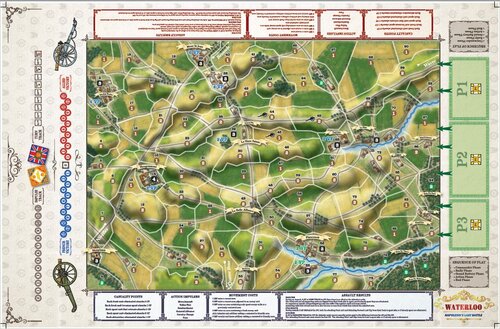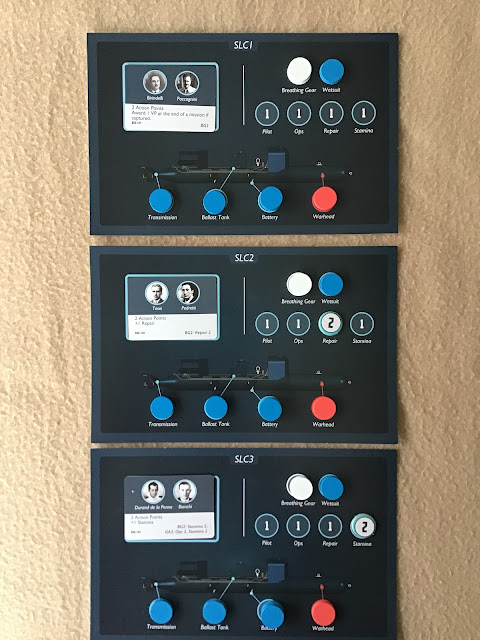Korsun Pocket 2
by
Pacific Rim Publishing
This is the Designer Notes for Korsun Pocket 2 that is on pre-order from Pacific Rim Publishing. The original Korsun Pocket is considered a milestone in wargaming history, and is worth hen's teeth now. Thank you Jack Radey, and Pacific Rim Publishing for allowing me to post this.
"Designer’s Notes
Korsun Pocket, Little Stalingrad on the Dnepr, was my first effort as a game designer. I fell in love with Jim Dunnigan’s and Joe Balkoski’s “Wacht am Rhein” back in the latter part of the 1970s. Immediately, I was thinking, “Gosh, that would be interesting on the other end of the war…” As I ruminated on the thing, the Korsun Shevchenkovsky Operation came to mind. I began to dig into it, and found it was just about the right size battle, and a very interesting situation. Whereas the Battle of the Bulge was pretty much a straight penetration and exploitation, Korsun Shevchenkovsky was an encirclement. Both sides would be attacking and defending. Great.
So I began digging, and found immediately that it is easier to research a game where at least one side wrote up their reports in English. But I taught myself some German, learned the Cyrillic alphabet and began to learn a little Russian. And I was aided by David Serber, who went to the archives in Washington and returned with a lot of German microfilmed records, and Leslie D’Angelo, who translated a chunk of Grylev’s “Dnepr, Karpaty, Krym” from Russian for me. Colonel John Sloan provided me Rotmistrov’s account of the battle, I translated part of Degrelle’s disgusting little book “Le Front D’Est” from French, and found the marvelous map collection at UC Berkeley. The game was proclaimed a masterpiece of research, and its researcher and designer a master of all things Great Patriotic Warish. Well…
Marx once described a fellow philosopher as “standing out like a high peak, due to the flatness of the surrounding terrain.” Wargame companies who were intent on staying in business did not devote a year to research for a game, no matter how big. The reputation I got has carried me far, but looking back, I do blush from time to time. But the world has changed… The Soviets, who documented EVERYthing, and valued their WWII experience as their national treasure, from which they drew their military doctrine, kept their data very close, and even Soviet historians had difficulty accessing it. So there were a lot of aspects of the battle that remained blurs to me. I had the basis for some guesswork, but some of it was based on SPI’s writings, and much of that was either grossly in error or was misunderstood by me.
But since those days, first perestroika and glasnost caused the archives to open for a while, before the sad passing of the USSR set in motion events that led to their reclosing. But the archives are all on war-time acid-based paper, and someone in the Russian staff realized that in twenty years or so they would be sitting on the world’s largest pile of dust. So they have begun scanning it and dumping it onto the internet… by the trainload. So when I asked my friend Charles Sharp to look into my guess that 4th Guards Army had attacked for three days and gotten nowhere at the beginning of the offensive, within 24 hours I had a rough summary of the Combat Journal of this army for the relevant days in my inbox, recounting precisely where the problems had been. Color me gob smacked. And then Helion Press brought out “Stalin’s Favorites – 2nd Guards Tank Army” (they were 2nd Tank Army at Korsun before they became a Guards army), with more detail on the strengths, losses, and activities of this army than I could have hoped to see in my wildest dreams. I have not completely re-researched the battle, this would require either exploiting the friendship I have with people who could do the massive amounts of translation that it would require, but I have gained a much more detailed understanding of the events of January and February, 1944. Consequently while you will recognize the basics of the game, there have been some changes, both based on better knowledge of the battle, and on some small knowledge of game design I have gained.

What’s the same? The basic Dunnigan/Balkoski combat and movement systems. My changes in the approach to Zones of Control, visibility, weather, etc. The broad outlines of the battle. The scenario structure. Much as one longs for a scenario for just the pocket, the notion of using all four maps just to play a small scenario seems silly. The map is pretty much the same, with a few additions. The rules about tanks are the same, but require some explanation. Why does a battalion of Panthers, say, with a tank strength of 4, break up into companies but still each has the same tank strength of 4? Shouldn’t it be less per company? After all, it’s less tanks… My thoughts, strongly supported by some friends who served in the armed forces, are that the difference between NO tanks, and a FEW tanks, is infinitely larger than difference between a FEW tanks and A BUNCH MORE tanks. The actual tank strength numbers, unlike the attack and defense strengths, are based on the effectiveness of the tanks weapons and armor. A tank with a bigger gun and heavier armor is inherently scarier and more destructive than more numerous tanks which have great difficulty damaging it. Tank size figures in to this too.
What’s different? Well, when I designed Korsun Pocket originally, I thought, “Amateurs talk tactics, professionals talk logistics.” And an encirclement battle was going to require a more detailed treatment of logistics issues. So I did some research and constructed a whole elaborate system for keeping track of supplies, and artillery ammunition (which makes up the bulk of supply tonnage). As game systems go, it worked, and pretty much produced the results I was seeking, namely that both sides were plagued by supply problems throughout the battle, as well as the supply challenge that a large encircled force produces. But looking back I fear that the operative words were “worked” and “plagued.” After the game came out, I figured out a truth of design. Time is the enemy of wargame design. Time is a constant, you only have so much of it to spend gaming, so much time you can get a team together, so much time that table will be useable. If there are a LOT of playing pieces in the game, it will take a lot of time to move them. A game with only a few pieces in play can have complex detailed rules. A game with a lot of pieces in it is already pushing the time envelope. Adding more work for the players… something will have to give.
So I set out to create a new and cleaner supply system. But being me, I dug into the research and found four credible sources who gave daily tonnage requirements for a full strength infantry or rifle division in combat. And got numbers that said 300+, 200, 100, and 20 tons a day, respectively. The 100-200 range seemed the most common number. True, none of these units was anywhere near full TO&E, but the fact is a badly worn infantry division will retain most of its artillery, even as its line infantry is worn to a nub. And artillery ammunition accounts for over 80% of the supply tonnage required. Worse, the 20 tons per day, derived from the deliveries by air to the pocket, are very well documented. I was pulling my beard out trying to come up with a compromise, so that a supply point would actually mean something in tonnage terms. And then…
I stepped back, squinted so I could not make out the details, only the broad outline of the problem. And it came to me. Doh. The bottom line truth is that while both sides experienced all kinds of problems getting supplies from railhead to fighting units, they succeeded in doing so sufficiently well to fight the battle. Only the pocket forces faced destruction when their supplies were cut off, first by land and finally by air. No complex systems, book keeping, supply points, or other fancy footwork required.
Similarly the air rules took a haircut. Bottom line, again, fighters were unable to prevent enemy air from having an effect on the battle, so why include them?
One other change evident is the counter mix. KP 1 had some holes that I filled with fudge. Some of the fudge has since failed to live up to the tasting. So: no more Ferdinands (it turns out the Soviets used the term “Ferdinand” to describe any assault gun), JS-2s, or T-34-85s. There weren’t any in the battle, they came out of my ignorance. No more killer cavalry units, they have been tamed a bit. No more tanks organic to panzer grenadier battalions, nor are the tanks that were part of 5th Mechanized Corps mushed into the motorized rifle battalions. This is a far better OB for both sides, I believe I have it all.
There is a matter that the players will have to ponder. In the order of appearance, there are a number of situations where units are required to exit the map, some of whom return, some do not. These units were usually withdrawn due to requirements for them somewhere outside of the scope of the game. Since players have no control of these events, this seems more than reasonable. The oddest may be the peregrinations of most of 5th Mech Corps, who immediately after the drive to Zvenigorodka, are forced to withdraw to the west, to reinforce a portion of the off-map front threatened by a German counterattack. After a difficult march, they were turned around and marched back onto the map area in the game, as by this time the Germans had ended their attacks and were shifting their panzers east, towards the Korsun Shevchenkovsky area.
But another matter entirely were the various inter-formation transfers that are called for in the order of appearance. While the Germans, sorely lacking in reserves, were known to pull a couple battalions from one division, attach an artillery battalion and maybe a company of antitank and another of engineers to a neighboring division in need of beefing up, the Soviets did a lot less of this. The exception would be their tank brigades, which would sometimes be detached from their parent tank corps and attached temporarily to another corps, or to a rifle corps or army when there was not an immediate need for a tank concentration. Then there is also the question of major reorganizations that happened historically. Towards the latter part of the battle, 27th Army of 1st Ukrainian Front was transferred to 2nd Ukrainian Front, in order to put the forces around the pocket under a single headquarters.
All of these decisions were historically made within the scope of the player’s discretion and in response to the developments in the battle. If the Soviets never formed pocket, would the inter-front transfer of 27th Army have happened? Would corps have transferred between armies had things gone differently? With this in mind, the players may choose to ignore all the transfers between on-map formations, or leave them up to the decision of the players – you could transfer 27th Army to 2nd Ukrainian Front, but you may decide not to. However, all withdrawals from the map are still mandatory."
Pacific Rim Publishing:
Pacific Rim Publishing (justplain.com)
Korsun Pocket 2:
Korsun Pocket 2 | Pacific Rim Publishing (justplain.com)


























































Follow Us